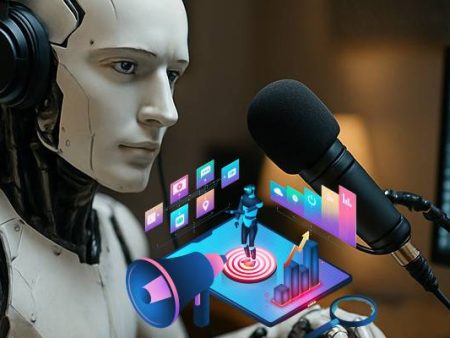The voice you hear on your phone, car navigation, or smart speaker might seem like a small convenience. But underneath that simple sound is a global struggle—one that involves billions of dollars, ethical dilemmas, and a fierce competition among the world’s largest companies.
We’re watching a battle between big tech giants in the AI voice race, and it’s not just about who makes the most human-sounding synthetic voice. It’s about control: of markets, of culture, and, ultimately, of how humans interact with machines.
If that sounds dramatic, it’s because it is. The stakes are bigger than we might think.
Why Voices Matter More Than Ever
Voices are intimate. They’re the first things we recognize as children, the soundscapes of comfort, guidance, and authority. When a brand—or a tech company—controls a voice, it’s essentially shaping human trust.
Think about it: you’ll forgive a bad touchscreen experience faster than you’ll forgive a voice that feels robotic or cold. A well-crafted AI voice can sound ready talk emotionally back, making conversations with machines feel less like transactions and more like relationships.
That’s why the giants—Google, Amazon, Apple, Microsoft, Meta, and a growing list of challengers—are throwing everything they’ve got into this race.
The Rise of Synthetic Cultural Voices
Not all voices sound the same, nor should they. The latest breakthroughs are not just about realism, but about diversity. Companies are experimenting with synthetic cultural voices—models that can shift accents, dialects, and linguistic patterns.
On the surface, this is exciting. Imagine a global app that lets you choose a voice reflecting your own community, or switch between accents for different audiences. It’s personalization taken to the next level.
But it also comes with baggage. Whose culture is being replicated? Were communities asked before their accents were used to train these models? Are these voices celebrating diversity, or just commodifying it?
This question hangs heavy over the industry, because technology often rushes forward faster than ethics.
Tools of the Trade: Behind the Curtain of Production
When we talk about the AI voice race, we can’t ignore the tools production that make it possible.
Modern voice generation relies on massive deep learning models. These models are trained on terabytes of speech data—everything from audiobooks to phone recordings, often scraped in ways that make privacy advocates cringe.
The training isn’t cheap either. One estimate from Grand View Research values the global text-to-speech market at $4.0 billion in 2022, projected to grow at a CAGR of 14.6% through 2030.
That’s not growth by accident; it’s growth fueled by investments from tech giants who see voices as the next frontier of human-computer interaction.
This infrastructure arms race is invisible to most users but central to the competition. Whoever builds the most efficient, realistic, and scalable voice engines will dominate.
The Legal Zone Using Voices
Here’s where things get sticky: the legal zone using voices is a mess.
Take the infamous 2023 incident where an AI-generated track mimicking Drake and The Weeknd went viral on TikTok. Millions loved it, but Universal Music Group quickly demanded takedowns, arguing copyright violation.
The problem is, the law hasn’t caught up. Are synthetic voices “derivative works”? Is cloning a celebrity’s voice without consent theft, parody, or innovation?
And what about everyday people? Imagine someone cloning your voice to make fraudulent phone calls. The risks aren’t abstract—they’re here. That’s why legal frameworks around AI voices are being debated urgently, with no clear answers yet.
Until those rules exist, companies and users alike are operating in a grey space, where innovation and exploitation are constantly colliding.
Who’s Winning the Race Right Now?
With products like WaveNet and MusicLM, Google has pushed the boundaries of natural-sounding voices. Its strength lies in scale and research infrastructure.
Amazon
Alexa is everywhere, and Amazon has leveraged that ubiquity to normalize talking to machines. Amazon Polly, part of AWS, is a leading player in commercial text-to-speech.
Apple
Apple takes a quieter approach, but its control over hardware (think Siri) means it shapes daily habits at an intimate level. Apple’s voices tend to be polished, but not always flexible.
Microsoft
With Azure Cognitive Services, Microsoft is building enterprise-ready tools. Its strategy is about integration—embedding voices into productivity and business systems.
Meta
Meta is newer to this space, but don’t count it out. With investments in AI-driven avatars and immersive AR/VR, the company is laying groundwork for voices in the “metaverse.”
This isn’t just a competition for products—it’s about who will define the default way humans expect machines to sound.
Beyond Big Tech: Challengers Enter the Arena
Startups like Descript, Resemble AI, and ElevenLabs are innovating faster than their corporate counterparts. Their models are lighter, cheaper, and sometimes more flexible.
In many cases, these smaller players are pushing the giants to adapt, forcing them to offer better customization, lower costs, and new features. Think of it as David keeping Goliath on his toes.
Why Emotion Matters in This Race
A voice isn’t just sound waves—it’s connection. Companies know this, which is why they’re working on models that are ready talk emotionally back.
Think about accessibility for the visually impaired. A natural voice can make reading an audiobook or navigating an app feel humane rather than clinical. Or customer service: would you rather be guided by a cold, robotic voice or one that sounds reassuring, like it actually cares?
Emotion in voices is the invisible currency of this battle. The company that gets it right may win loyalty far beyond technical specs.
The Dark Side: Misinformation and Manipulation
We can’t have a conversation about AI voices without touching on deepfakes. Political campaigns, fraudulent schemes, and propaganda are all potential use cases for synthetic voices.
In 2024, the FTC issued warnings about scammers cloning voices to trick families into giving money. That’s not sci-fi—it’s happening.
Here’s the irony: the same realism that makes voices good for accessibility and customer service also makes them dangerous in the wrong hands. This duality is part of why regulation feels so urgent.
My Take: More Than a Tech Story
I’ll be candid—I’m conflicted. On one hand, I’m amazed at the artistry and technical genius of these systems. On the other, I’m uneasy about the consequences.
Hearing a synthetic cultural voice sing a folk song can feel like celebration—or like theft, depending on context. Listening to a customer support agent that sounds ready talk emotionally back can be comforting—or manipulative if it’s pushing you to buy something.
This is why we need open dialogue, empathy, and regulation. Otherwise, we’re just sprinting into the future without looking where we’re going.
The Future: Where Do We Go From Here?
The battle isn’t slowing down. If anything, the arms race is accelerating.
We’ll see:
- Hyper-personalization: Users choosing voices that reflect identity, mood, or even context (a calm voice for bedtime reading, a lively one for workouts).
- Cultural expansion: More accents and languages, raising both opportunities and ethical challenges.
- Regulatory frameworks: Governments drafting laws to define the legal use of AI-generated voices.
- Hybrid experiences: Human and AI voices blending in new creative works, from music to audiobooks.
And maybe, just maybe, a moment when we step back and ask: are these voices making us feel more connected—or less?
Conclusion: It’s Not Just a Race, It’s a Mirror
The battle between big tech giants in the AI voice race isn’t just about technology. It’s about us—our trust, our comfort, our culture.
Voices carry weight. They carry history, identity, and emotion. As companies roll out synthetic cultural options, refine their tools production, and stumble through the legal zone using voices, we need to stay vigilant.
Because in the end, the winner won’t just be the company with the best algorithm. It’ll be the one that understands what people truly want: voices that don’t just sound human, but voices that feel human. Voices that are ready not only to talk, but to talk emotionally back.
And maybe that’s the finish line worth aiming for.


